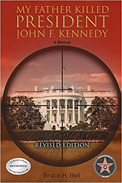
 |
The Warren Commission concluded that Lee Harvey Oswald acted alone to assassinate President John F. Kennedy (JFK) on November 22, 1963. Bell is not Lee Harvey Oswald's son, and he does not believe Oswald murdered JFK. Instead, Bell reveals in great detail how his father was the man who killed the president.
Bell's father was ultra-conservative Orris Bell, a handsome, charming, philandering, and intelligent bigot who became vice president of sales for the U.S. Chemical Milling Corporation (U.S. Chem), a company that milled metals for Intercontinental Ballistic Missiles (ICBMs). Orris, a married father of six, cultivated powerful connections in the government and the Mafia and, according to his son, spearheaded the conspiracy to kill JFK, a man he believed would surrender the United States of America to Russia.
Conspiracy theories are nothing new, and some have even proved true, such as the group plot to assassinate Abraham Lincoln and the Nixon administration's cover-up of the Watergate break-in. Many still question how a lone, uneducated misfit like Oswald could have planned and executed JFK's death in crowded Dealey Plaza in Dallas. At least 10,000 books have been written about JFK's assassination, as well as more than a dozen films. What sets Bell's conspiracy concept apart from others is twofold.
First, there is Robert Groden, who wrote the introduction. Groden has studied the Kennedy assassination for over fifty years and has authored fourteen publications about the tragedy's physical evidence. He was a consultant for Stone's JFK film. Before this, Life magazine hired him to work on the Zapruder film, the 26.6-second, 8 mm movie Abraham Zapruder shot of Kennedy's assassination. Groden retained an unauthorized copy of Zapruder's film. He and Dick Gregory (the late comedian and civil rights crusader) premiered the startling footage to the public on March 6, 1975, during Geraldo Rivera's Good Night America television show. Groden believes Bell's story "rings true" because of his ability to "name the names and motives of those involved."
Second, Bell employs a unique perspective. He writes about the inner workings of the conspiracy from his perspective as a boy aged nine through thirteen. His father took him to countless off-site assassination planning meetings involving figures from the FBI, CIA, Mafia, and the Military Industrial Complex (i.e. the term President Dwight D. Eisenhower coined in his farewell address to the nation in January 1961). The young boy's presence was a "cover" for the seriousness of the gatherings and a sounding board for his dad. The author would often miss two or three days of school a week, and weekends frequently involved sitting in restaurants, conference rooms at U.S. Chem (a CIA front), or hotel suites, listening to all the ways that JFK, the liberal, Catholic president, was a threat to the nation.
For the tender-hearted, Bruce's narrative evokes swells of empathy and sympathy. He was a little boy who wanted to play football, have friends over, and be a normal child—not a keeper of his father's secrets and terrified of discovery. He was a shield against prying eyes that might have questioned why high-level men were meeting so frequently. Especially tragic is that the grown-up author knows he was used. Even so, he honored the commitment to his parents and published his memoir only after their deaths, hoping to spur further investigation into the assassination.
Whether one believes the author or not, Bell provides a marvelous overview of key political markers from 1960 through 1963. He outlines mistakes made in The Bay of Pigs invasion and the Cuban Missile Crisis, as well as the origins of the Cold War with Russia and the uncertainties involving Vietnam. The cast of who's who is jaw-dropping. The author is familiar with General Curtis "Bombs Away" LeMay, General Charles Born of World War II fame, civilian director of the CIA Allen Dulles, FBI director J. Edgar Hoover and his lover, the rich ultra-conservative Clint Murchison, Sr., and Mafia bigwig Sam Giancana. He met and disliked Jack Ruby, even though his father brought him matchbook covers for his collection. Oswald became a friend, and his "fall guy" status and murder greatly upset the author.
The best conspiracy theories contain a kernel of truth. History knows that JFK moved quickly to accomplish much and stepped on many political toes in the process. The men mentioned above are figures he likely could have, or did, disagree with. JFK's brother, Robert, certainly started the war against the Mafia. The Joint Chiefs of Staff disagreed vehemently with JFK on handling the Bay of Pigs crisis. JFK fired Allen Dulles. Hoover did not approve of JFK's private life.
Readers will undoubtedly see how tragic it was to bring a little boy who worshiped his dad into this American swamp. He was privy to almost every step in a convoluted plot that arranged the men, the weapons, the place, the time, the "fall guys," and the cover-up. Bell doesn't flinch from honestly revealing who was selected for each task and why, explains the secrets of the "magic bullet" and the "umbrella man," reveals the three shooters' identities, discloses who shot J.D. Tippit, lays bare the assassination's aftermath, and much more. Bell's writing is especially masterful in the schoolroom scene where his younger self reacts to the "news" of JFK's death, which he knew of two days earlier.
Bell's memoir about a conflicted boy dragged by his masterminding father into the sordid plot to murder JFK sparks sadness, anger, doubt, and fear. Regardless of one's take on the author's narrative, the story remains sincere, well researched, and a thought-provoking look at one of the most controversial political assassinations of all time.